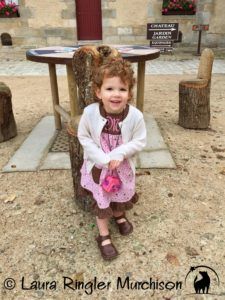
This was the day we set out for tours of Vaux-le-Vicomte and Fontainebleau. We began with the baroque French chateau Vaux-le-Vicomte, located about 34 miles southeast of Paris. It was here that the architect Louis Le Vau, the interior artist Charles Le Brun, and landscape designer Andre Le Nôtre began their collaboration, creating the “Louis XIV” style. Once a small chateau between the royal residences of Vincennes and Fontainebleau, the estate of Vaux-le-Vicomte was purchased in 1641 by Nicolas Fouquet, an ambitious 26-year-old member of French Parliament. To secure the necessary grounds Fouquet purchased and demolished three villages, with the displaced villagers then employed in the upkeep and maintenance of the gardens. It was said to have required more than 18 thousand workers and cost as much as 16 million livres at the time. While Fouquet’s intentions were to flatter the king, his plan backfired. Jean-Baptiste Colbert led the king to believe that his minister’s magnificence was funded by the misappropriation of public funds. Colbert replaced Fouquet as the superintendent of finances and had him arrested. The king then seized, confiscated, or purchased 120 tapestries, the statues, and all the orange trees from Vaux-le-Vicomte. After which he summoned Fouquet’s team of artists (Le Vau, Le Brun, and Le Nôtre) to design what would become the palace and gardens of Versailles. That afternoon we headed to Fontainebleau, a town a little farther south of Paris, known for its opulent palace by the same name. Built by French royalty with parts dating back to the 1100’s, its formal gardens feature ornamental lakes and sculptures. This hamlet was endowed with a royal hunting lodge and a chapel by Louis VII in the middle of the twelfth century. A century later, Louis IX (also referred to as Saint Louis) held Fontainebleau in high esteem and referred to it as “his wilderness.” The Palace of Fontainebleau was transformed into a royal chateau between 1494 and 1547 by the great builder-king Francis I. During that time every monarch, from Francis I to Louis XV, made important renovations at the Palace of Fontainebleau. In 1762 the Treaty of Fontainebleau, a secret agreement made between Spain and France concerning the Louisiana territory in North America, was concluded there. The horseshoe staircase at its front remains both haunting and impressive. I remember our little one was so happy feeding the ducks at the royal lake; a respite from stuffy old rooms. Given that she was the only person under the age of about 40, I think she did terribly well. The American longest-serving First Lady of the United States, Eleanor Roosevelt, once said:
“I think, at a child’s birth, if a mother could ask a fairy godmother to endow it with the most useful gift, that gift should be curiosity.”
I have always had an insatiable thirst for knowledge. One of the things that drew me to my husband is that he inherently has it as well. I believe our baby doll is already displaying that need to know and learn and we are thrilled. With the desire to sate her innate curiosity, she will have the world at her fingertips, ma petite poupée.
